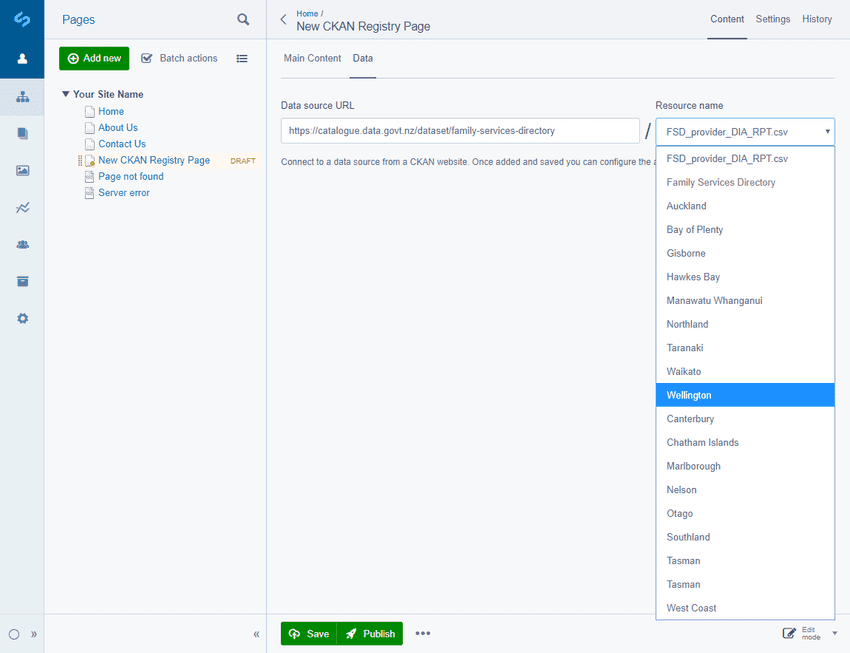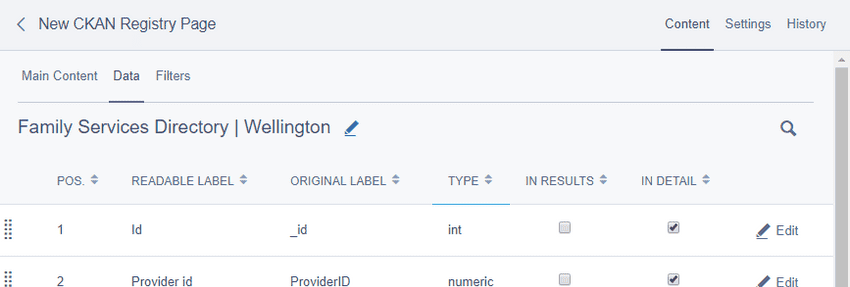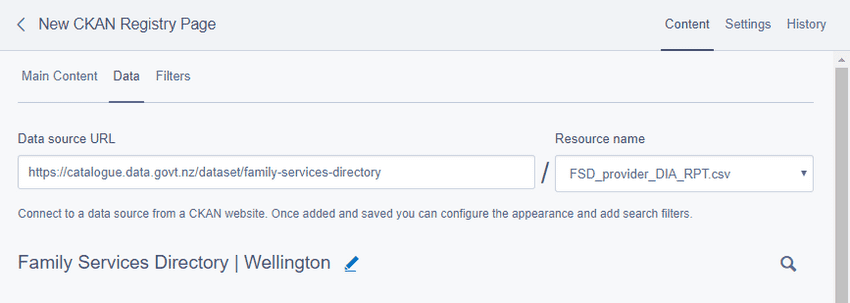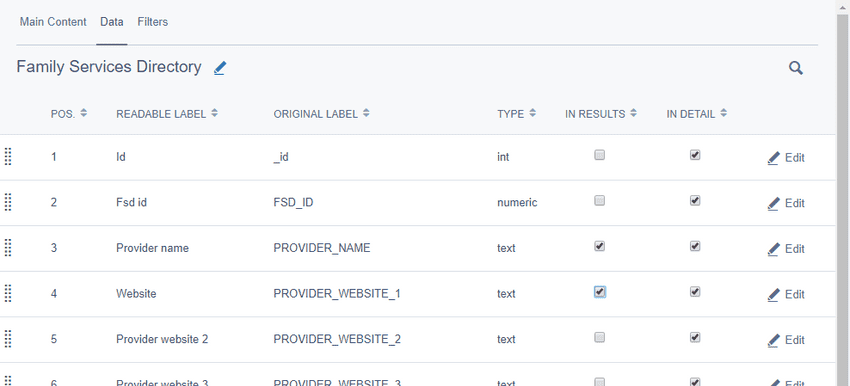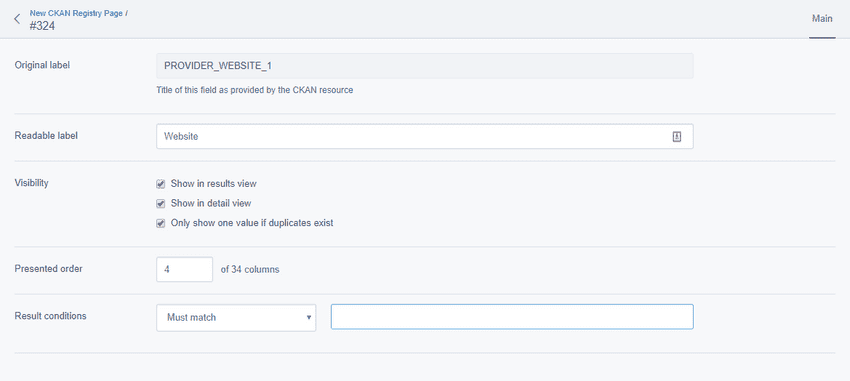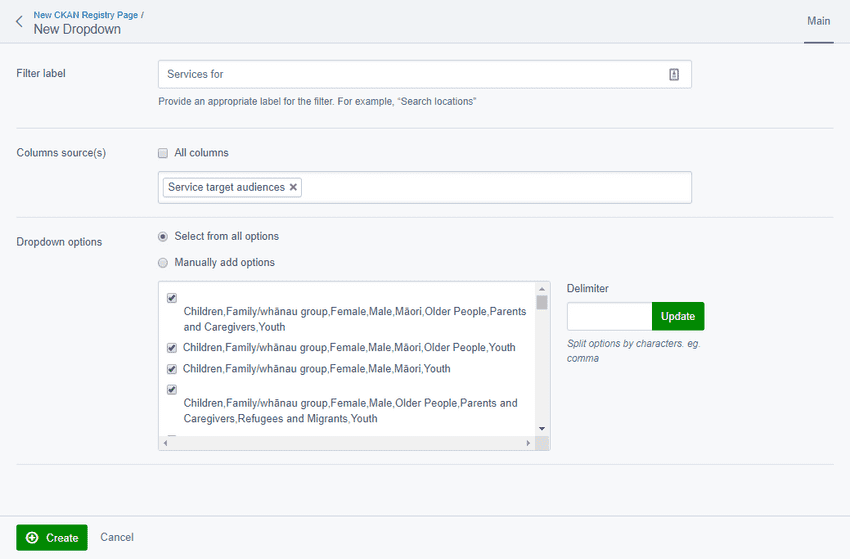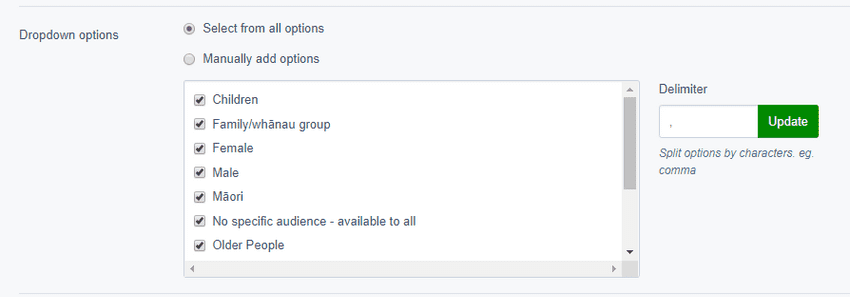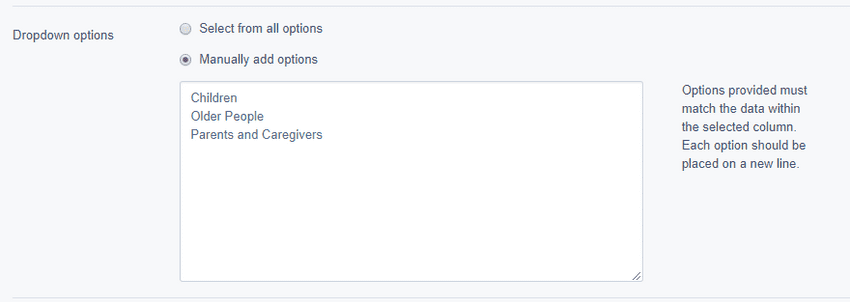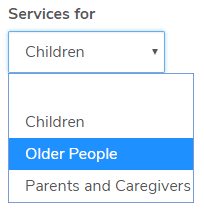Features
- Loading resource data
- Changing resource data
- Configuring data columns
- Configuring how fields are displayed
- Configuring how users can filter data
The CKAN Registry module adds a new CKAN Registry Page page type to the CMS, allowing a content author to add pages that allow customisation and display data of data from an external CKAN resource to website visitors.
CKAN (Comprehensive Knowledge Archive Network) is a powerful data management system that makes collections of data accessible – by providing tools to streamline publishing, sharing, finding and using data. It is used by national and local governments, research institutions, and other organisations who collect a lot of data.
After creating a new CKAN Registry Page, the normal page editing options are available to the content author, along with a new tab called Data. This tab will allow one to paste a CKAN datastore resource URL into the Data source URL field.
This field will then load data from CKAN, providing a list of resources available on that dataset if applicable, and preselect one if the URL was for a resource rather than a dataset.
Loading resource data
Once a valid resource has been chosen, click the button Save. SilverStripe will then import a list of all the fields available on that resource, listing them down the page, and a new tab will appear - Filters. Filters will allow frontend website users to filter the CKAN data, and will be discussed in more detail below.
Changing resource data
To change the resource after the page has been saved, click the button Edit shown as a pencil icon next to the dataset title.
Configuring data columns
The list of fields has two checkboxes: Results and Detail. The former disabled by default and the latter enabled by default for all records. These options control whether the column will be displayed in the list results view and detail view respectively, and will be explained in detail in the next section.
Configuring how fields are displayed
The list of fields will be shown to a visitor as columns in a table, and there are a number of options available to the CMS author to configure.
Each field can be configured as such:
- The Original label is not editable, and serves to indicate the source of the data as coming from the CKAN resource.
- The Readable label allows the label/name to be altered to be more readable if the one imported from CKAN is undesirable for any reason. By default this is automatically generated from the Original label.
- If Show in results view is checked, this field will be shown as a column on the field site visitors will see, otherwise it will not be shown. At least one field must be selected to be shown to the user.
- If Show in detail view is checked, this field will be shown in the detail view that opens when a visitor clicks a row on the table shown to them. This is enabled for all fields by default.
- If Only show one value if duplicates exist is checked, removes one of two (or more) results that have the same data in the result set shown to the website visitor.
- Presented order allows an author to change the ordering of columns with more precision than dragging and dropping items in the CMS table. This also makes it easy to move items between pages.
- The Result conditions allow for a "pre-filter" to be chosen to only show results matching (or not matching) a particular value.
Configuring how users can filter data
The Filters tab allows a CMS content author to configure fields shown to a visitor that will allow them to refine the results shown to them. One is always created by default after selecting a resource and saving the page. This default filter is a text type that searches all columns for matches on the visitor's search term.
By default there are two types of filters available for a content author to configure:
- Text: allows a user to enter text to filter results.
- Dropdown: only allows a pre-defined value to be chosen.
Configuring a text filter
- Filter label provides an appropriate label, e.g. "Search locations".
- Column sources allow the filter to be configured to either search all columns, or if the checkbox is unselected to search only a particular column or set of columns (multiple may be chosen).
Configuring a dropdown filter
This filter type has only one extra configuration option from those provided by the text filter; the ability to supply filter options for the user to choose from.
Select from all options
After choosing which columns the filter will apply to, the Select from all options area will update to provide a list of all possible unique values those columns contain. The content author can then choose to disable any of these options by unselecting the corresponding checkboxes.
Splitting delimited cell values
In some cases, multiple values are contained in a single column on a row. For example, in the Family Services
Directory we can see a SERVICE_TARGET_AUDIENCES column that contains multiple values in some rows, separated by
a comma (e.g. "Children,Youth").
To get these values to display as both "Children" and "Youth" we can enter a comma into the Delimiter box; after clicking Update the list of options to will update to be separated appropriately.
Manually add options
The Manually add options entry box for this allows values to be entered directly by the content author, one option per line.
E.g.
Children
Older People
Parents and CaregiversThis option is available for cases where it might be easier to list out known values in advance, rather than to enable or disable provided values individually.
This is displayed to visitors using the CKAN modules default presentation. For more information on customising the default presentation see Frontend example application.
